Elbow
Elbow Anatomy
The elbow is a hinge joint between the upper arm bone, which is called the humerus, and the lower arms bones, which are called the radius and the ulna. The ulna is on the inside of the elbow, also called the medial side. The radius is on the outside of the elbow, also called the lateral side.
For the elbow to function normally, it is stabilized by strong ligaments on both the inside and the outside. These are called the collateral ligaments. These ligaments prevent the elbow from bending to the side. A ligament is a band of connective tissue that connects two bones together. In the elbow, the inside ligament is called the medial collateral ligament or the ulnar collateral ligament. The outside ligament is called the lateral collateral ligament or the radial collateral ligament. These ligaments can be injured by dislocations of the elbow, fractures of the elbow, surgery upon the elbow, or repetitive overuse.
The elbow also has multiple crossing muscles. The biceps muscle has a tendon to attach the muscle to the bone at the elbow, called the “distal” biceps tendon. In the elbow, the biceps tendon attaches to the radius bone. This muscle is important for bending the elbow, but it is even more important for rotating the forearm from the palm down to the palm up position. It is one of the only muscles that performs this motion. This motion is important for normal arm function in daily activities. The distal biceps tendon can be torn from its attachment to the bone by injuries that involve heavy lifting or a sudden resisted straightening of the elbow. The triceps muscle, which extends the elbow, also has a tendon to attach the muscle to ulna bone. However, this tendon is torn only very rarely. There are also tendons on the inside of the elbow, the “medial” side, to bend the wrist. There are tendons on the outside of the elbow, the “lateral side”, to straighten the wrist. These tendons attach to a bone projection called the “epicondyle.”
Elbow Arthritis
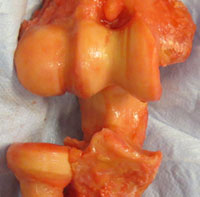
Elbow osteoarthritis is a “wear and tear” disease in which the cartilage surfaces of the joint become damaged. Arthritis creates inflammation, swelling, pain, stiffness, and weakness. In an attempted healing response, the bone around the joint creates bone spurs that can limit motion and create pain at the end range of motion.
Baseball-Related Elbow Injuries
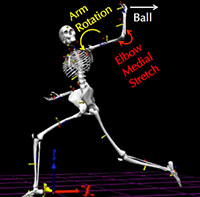
The overhand baseball pitch is among the fastest and highest stress athletic motions known. Within this motion, rotational speeds exceed the equivalent of 20 revolutions per second, or the equivalent of a tire turning at 60 miles per hour. Most of the speed of the baseball pitch is produced in the legs and trunk.
Elbow Dislocation
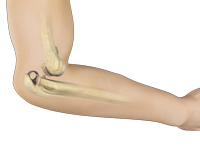
Because the bony surfaces of the elbow fit together tightly dislocations of the elbow are uncommon and usually require a forceful trauma. Many elbow dislocations are associated with broken bones within the elbow and these injuries are called “complex dislocations” almost always require surgery.
Bicep Tendon Tear at Elbow
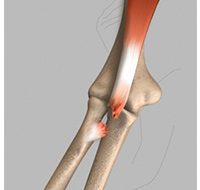
The biceps muscle has a tendon to attach the muscle to the bone at the elbow, called the “distal” biceps tendon. In the elbow, the biceps tendon attaches to the radius bone. This muscle is important for bending the elbow, but it is even more important for rotating the forearm from the palm down to the palm up position.
Ulnar Nerve Entrapment (Cubital Tunnel Syndrome)
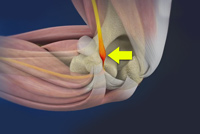
The ulnar nerve can become pinched within the cubital tunnel. Pinching of this nerve causes elbow pain, numb and tingling feelings within the hand, and weakness in the hand. This problem can be caused by accidents or injuries, bone spurs within the elbow, or ligament tears within the elbow. Often there is no known cause.
Tennis Elbow

Lateral epicondylitis, more commonly called tennis elbow, is the most common cause of elbow pain and occurs in a large portion of the population between the ages of 40 and 60. This condition is a degeneration of the tendon of a muscle that bends the wrist back.
Tommy John Surgery

Surgery to restore the ulnar collateral ligament is commonly called “Tommy John” surgery after the first pitcher on which the procedure was performed. In this procedure the ligament is reconstructed with a tendon graft. Forearm tendon graft, leg tendon graft, and cadaver tendon graft can all be used successfully for the procedure.
Elbow Arthroscopy
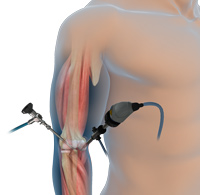
Arthroscopy is a minimally invasive way to perform elbow surgery. To perform an arthroscopy Dr. Chalmers will make a small incision 5 millimeters (1/4th inch) and insert a small fiberoptic camera into the elbow joint. Once the joint is filled with saline fluid, the entire elbow joint can be visualized using the camera.
Steroid Injections

Corticosteroids are the strongest available anti-inflammatory medications. Weaker anti-inflammatory pills such as ibuprofen, advil, naproxen, and aleve, are some of the most commonly utilized medications in the United States. Corticosteroids are available as pills. These pills generally must be taken every day or several times a day.
Distal Biceps Repair
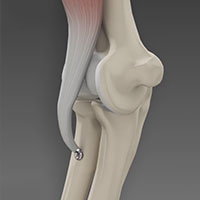
The distal biceps tendon can be torn from its attachment to the bone by injuries that involve heavy lifting or a sudden resisted straightening of the elbow. This injury creates pain and bruising in the front of the arm. After the tendon tears, the biceps muscle retracts upwards, changing the contour of the arm. This is frequently called the “popeye” arm.
Elbow Ligament Reconstruction
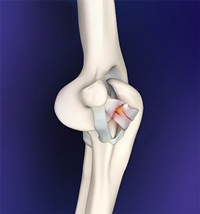
Many elbow dislocations are associated with broken bones within the elbow and these injuries are called “complex dislocations” almost always require surgery. Other elbow dislocations are not associated with any broken bones and these injuries are called “simple dislocations” and almost always can be treated without surgery.
